I’m as guilty as the next tourist of wanting to have the “authentic” experience in a new-to-me destination. So when we visited Venice, I selected a lovely apartment in the Cannaregio neighborhood to get away from other tourists. Of the six districts in the city, the Cannaregio was one of the quietest. More importantly, it was one of the few places where it was still possible to spot that rarest of creatures—a local.
The brick building that housed our apartment rose from the murky bottom of the Rio dei Miracoli, the River of Miracles, a name that I thought demanded quite a lot from a twenty-foot wide, stagnant and oil-slicked body of water.
The river flowed parallel to the apartment’s kitchen and master bedroom, and in the evening, I threw the windows wide to the green water and the Campo Santa Maria Nova across it. A restaurant had opened for the night, spilling yellow light into the square. Bistro tables set with flickering candles filled with patrons, and their happy chatter wafted into our kitchen while I cooked dinner.
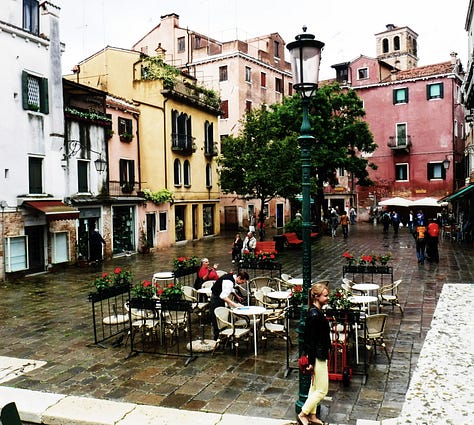

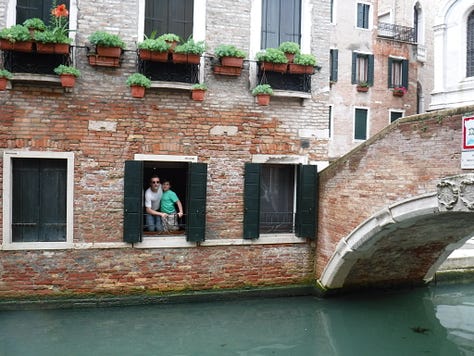
After several minutes, a man’s head and black-and-white-striped torso glided past the windows. He stood on the end of a black gondola manning a long pole for two tourists seated hand-in-hand. They slid beneath the bridge, the gondolier’s melodious voice amplified, “And here, we have the Church of Saint Mary of Miracles. It was built in 1489…”
I had noted the church he referenced when we moved in. Its architecture was unique in that the roof was semi-circular, a barrel vault rather than the more common gabled roof. I hadn’t yet had the chance to peek inside.
Half an hour later, another gondolier floated past. He was already mid-speech in a cadence that suggested he’d said the words many, many times before. “Beyond the bridge is the Church of Saint Mary of Miracles, built in 1504.”
I stopped stirring the pasta on the stove. “Didn’t the last guy say a different date?” I asked Tim. He and Aidan were sitting at the little table by the windows, not two feet away from the water traffic. Tim shrugged.
Shrugged. FIRST, as though the information were not interesting enough to pay attention to. And SECOND, as if it were a matter of no import in which year the church was built. Barbarian.
As a graduate student in the art history department of Rutgers University many years before, I had once taken issue with a fellow student when, during a presentation in a Roman art class, she casually mentioned that Octavian had defeated Mark Antony and Cleopatra in 35 BCE.
35 BCE?! I goggled at her. How could she make such a mistake? Didn’t everyone carry an accurate mental spreadsheet of Roman battle dates?
My only course of action for such a Rubicon-sized offense was the art historical equivalent of slapping her with a white leather glove and challenging her to a duel. In front of the professor and the whole class, I corrected her. “I believe the Battle of Actium occurred in 30 BCE.” Because that’s the kind of humble, empathetic team player that I was when it came to history.
Gondolier number three rowed by when the family was mid-ziti at the dinner table. “The church on your left was built in 1478...” I choked, incensed. The blatant disregard for historical accuracy was a grievous violation of…of…
Did gondoliers have to take some kind of Sacred Pledge? Like doctors with the Hippocratic Oath. Or abide by some Standards of the Profession?
It seemed to me that gondoliers, neigh, tour guides the world over, were duty bound to deliver factual information. There should be a Global Tour Guide Convention, like the Geneva Convention, but to establish the minimum protections and standards of humane treatment of tourists affected by lack of knowledge. It was for the good of humanity.
I decided there and then that I was going to find out the ACTUAL date of that church for myself, by God. And expose the seedy underbelly of shoddy, gondolier-glossing history to the next hapless tourists that slid by the window. Surely they would like to know that they had paid for inaccurate information.
The next morning, I stalked through the church’s open wooden doors on a mission. There must be a tri-fold paper pamphlet somewhere with the church’s history printed on it.

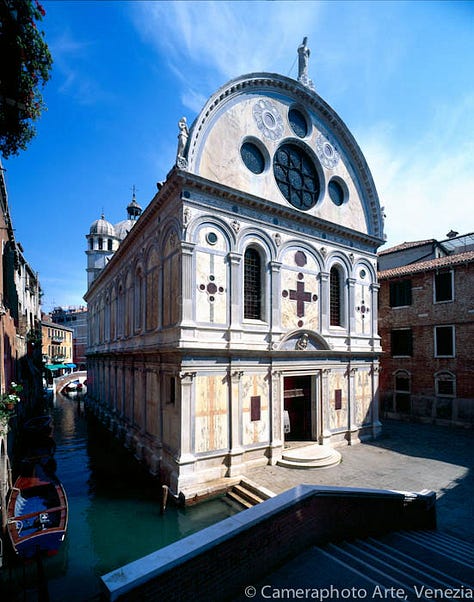
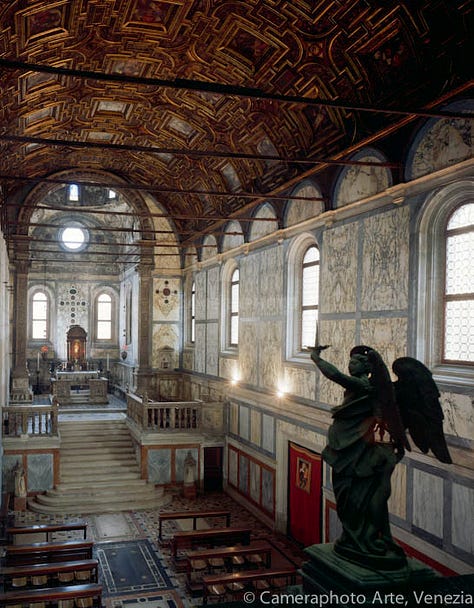
As I’d suspected, a wooden table by the entrance held a box for donations and a page of information in Italian and English. I perused: The church was commissioned by Angelo Amadi to house a miraculous icon of the Virgin with Child. It was created by the artist Pietro Lombardi and his workshop in the Renaissance Venetian style with polychrome marble during the fifteenth century.
Fifteenth century? That was it? Did the custodians not know the date of their own church? What other possible reason could there be not to include it?
I walked deeper into the church to scan the marble walls for inscribed dates, imagining what AD 1499 might look like in Roman numerals. I broke it down: 1000+(500-100)+50+10+10+10+(10-1) converted to…MCDLXXXIX. It was enough letters to give me a headache.
The interior of the church received no direct sunlight, but was nevertheless bright. White and gray marble walls were clean and uncomplicated by adornments, soaring up to the coffered, barrel-vaulted ceiling. It was vastly different in style than my local church had been with its green rug, horse-hair plaster walls and stained-glass windows. Still, they both held that same meditative silence that made them feel slightly outside of real time.
The only other person in the church was an elderly woman kneeling in a front pew. Her head was bowed, and she wore a kerchief over her hair. On the floor beside her, a cloth bag rested, a leafy head of lettuce or celery protruding from the top as though she had stopped in on her way back from the market. A local! I wondered how long she’d been attending Santa Maria. Since she was a child?
It occurred to me then that I had no idea when my own church had been built. Not the one that I had attended as a child, and after it was bulldozed, not the one whose construction I witnessed to replace it either. But I recalled kneeling on red velvet, enveloped in incense, poinsettias carpeting the altar, the choir harmonizing, the bell ringing, and how I felt part of something bigger and older than I was.
I completed my inspection of Santa Maria. There weren’t any dates inscribed anywhere in the church. I was disappointed, but it felt less of a travesty than I expected it would.
My mission failed, I determined to do a Google search as soon as reliable Wifi was restored. My undertaking fell by the wayside, though, when Tim went to visit some friends in Bologna and I took on a new mission to become the fun parent while he was away. I left Venice without ever knowing the date.
Years later, when the family went to see Kenneth Branagh in the movie A Haunting in Venice, I was delighted to see the church and the apartment in the background of an opening scene. They evoked a claustrophobic and eerie mood in the context of the film.
I thought back to the tourists in the gondola floating by the kitchen window. They were holding hands, smiling in the slanted sunlight in a romantic and unforgettable experience. Likely they hadn’t even been paying attention to the voice of the gondolier droning on in the background.
As much as it pained me to admit it, I supposed the actual date of the church was, under the circumstances, beside the point. Most (normal) people won’t remember a date, but they will remember a feeling. I decided that on that day with a tourist-trap gondolier, gliding along the River of Miracles while listening to fictitious facts, that couple had nevertheless managed to have an authentic Venetian experience.
Free Reading
Each morning, The Sample sends you one article from a random blog or newsletter that matches up with your interests. When you get one you like, you can subscribe to the writer with one click. Sign up here. You get more of what you like, and it helps to support my newsletter at no cost to you.






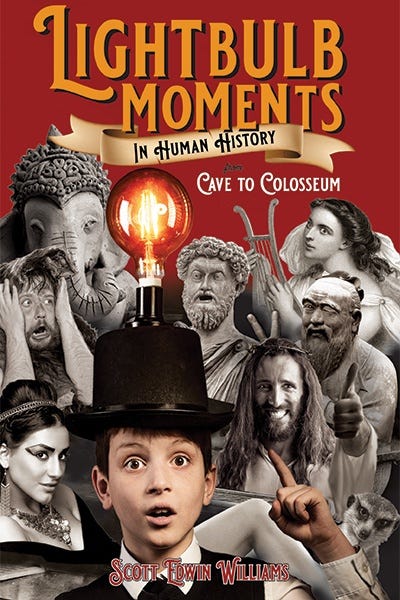

While I agree with your conclusions, I do think tour guides have a fiduciary duty to be accurate. A world where guides play fast and loose with dates - their own version of alternative facts - is a terrifying prospect. Perhaps the International Committee of Tour Guides should look into this.